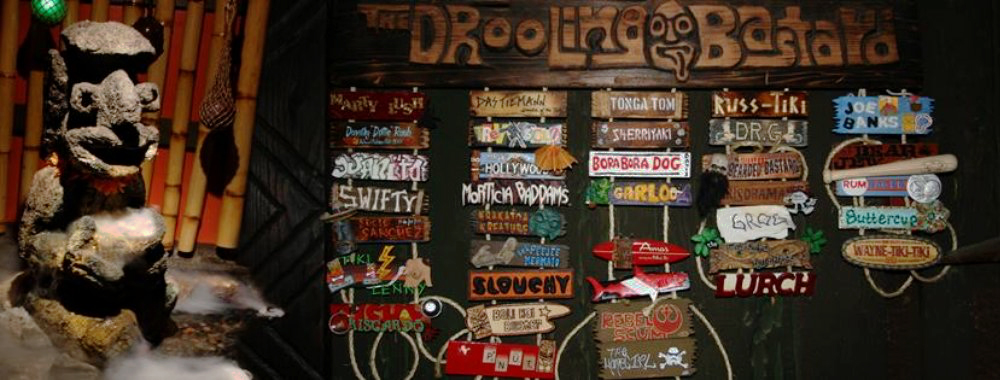Though journalists love to throw around the word “resurgence” when it comes to food, drink and nightlife, it’s mostly an overzealous editor’s way of hyping something that was already beloved, albeit usually by a niche contingent. Take the tiki “trend.” Tiki is influencing both the mainstream (TGI Fridays and Red Robin currently tout tiki-inspired libations) and more mixology-driven establishments around the country, but that doesn’t mean it was ever really absent — and it’s definitely not new. Hardcore tiki fans, in fact, take issue with the media blitz their community has been exposed to lately.
Tiki drinks are not about the umbrellas, or the vessels with funny faces they’re served in, or even the rum grade or age. Tiki is about alchemy, and history, and — however hokey it may sound — escapism in a glass.
The people who love this culture live it, hellacious hangovers be damned. If one endeavors to write about tiki culture, especially tiki bar culture, they better know their Painkiller from their Planter’s Punch. And the most comprehensive tiki education can be found in Jeff Berry and Annene Kaye’s “Beachbum Berry’s Grog Log.” Both a history tome and a recipe book, the Grog Log contains 78 vintage tiki cocktails from the most renowned bars and liquor purveyors around the world. While I had seen it sold in kitschy shops alongside ceramic mug displays, that was pretty much all I knew about it until a year ago, when I embarked on a tiki quest of epic proportions.
BOOKS, BLOGS, BOOZE
I’ve been covering cocktail culture and bars mostly for the LA Weekly for nearly two decades. I even wrote a book about the city’s oldest and most revered (or reviled, depending on your taste) watering holes. In my book, a couple tiki bars made the cut, not because they were austere in any way, but because of their history. Tonga Hut, which opened in the San Fernando Valley in 1958, is technically the oldest. Though it went through a sort of non-tiki, generic period, it’s come back strong in the past decade, topping LA’s tiki scene with a vast menu that respects the past even as it pushes forward with creative new potions and innovators behind the bar. Over the years, Tonga Hut has steadily built a dedicated following of tiki folk and “groggers.”
And I mean dedicated. Six years ago, Tonga Hut created a challenge for its drink denizens that tiki aficionados couldn’t refuse: imbibe all 78 creations listed in Berry’s book in one year, and you become part of their honorary club, The Loyal Order of the Drooling Bastard (named after the tiki fountain near its entrance). Those who enlist in the challenge are given a checklist of drinks, which your bartender checks off as you drink them each visit. Upon completion, you are celebrated with a ceremonial “bastardization,” a tiki necklace (good for a dollar off of drinks at Tonga Hut for life) and a plaque with your “tiki name” on their Drooling Bastard wall.
TRADERS & COMBERS
I started the Grog Log on July 6, 2014 and finished on June 28, 2015. (I should disclose here that I also started dating a bartender at the Hut just before embarking on this journey, so it was as much about the intoxication of a potential love interest as it was about researching cocktail culture.)
When considering tropical drinks, it all begins with the Mai-Tai. The best always feature Jamaican rum and fresh lime juice with hints of orange, almond and mint for garnish. Though Don the Beachcomber had a version of the Mai Tai back in 1933, the Grog features Trader Vic’s recipe (“lime juice, Curaçao, orgeat syrup, and rock candy syrup”) widely regarded as the classic we know and love today. It’s also ubiquitous; hence, at Tonga Hut, groggers are given an automatic Mai Tai credit on the checklist, leaving 77 other drinks to try from Berry’s book. But just how does one begin this ambitious endeavor? The Tonga’s checklist, like the Berry book, lists drinks by alphabetical order, but the back of book glossary also lists them by size and prominent alcohol ingredient (rum, vodka, gin and bourbon).
I decided to go totally random in my approach. On Sundays, when I’d usually show up to “work” on this project (and, okay, flirt with the bartender), about half the people inside were also working on their Grog Logs as well. It became a bonding experience to order the same creations together and compare and contrast our impressions. Plus, for a bartender, making five “Missionary’s Downfalls” at once is a lot easier than making them individually throughout the night. It’s not just a huge time saver — it makes for some festive toasts with strangers, too.
 A sampling of the colorful concoctions from Beach Bum Berry’s “Grog Log.”
A sampling of the colorful concoctions from Beach Bum Berry’s “Grog Log.”
FROM SWELL TO HELL
For the most part, groggers tend to agree on which drinks make the taste buds sing and which make them shriek in agony. Some of the Log’s best? The Painkiller, Trader Vic’s Grog, the Hurricane (from Pat O’Brien’s restaurant in New Orleans circa 1960), the Rum Barrel (from Port o’ Call restaurant in Arizona circa 1960s), the Pieces of Eight (from the restaurant of the same name in Marina Del Rey, California circa 1962) and the Ancient Mariner, which starts off the book and the challenge on a tasty high note with a hodgepodge of Jamaican rum, Demerara rum, Pimento liqueur, grapefruit, lime and sugar. The Mariner, interestingly, is not a vintage or “found” recipe from the ‘50s or ‘60s like everything else in the book, but in fact, Berry’s own concoction. All the aforementioned are rum drinks and have certain flavor profiles in common; namely, fruity accents, juices and syrups that complement the potent undercurrents in the hard stuff.
The not-so-great drinks lack this symphonic mix of sugars and spirits. Tropical drinks, like all drinks really, need balance. And when one ingredient overpowers the others, the result can be vile. I was warned by the older “Bastards” about a few on the list before I drank them, so I prepared myself accordingly. Nothing was that bad, but that doesn’t mean they were good either. In particular, Hell in the Pacific ( a version of the Myrtle Beach punch popular in the 1930s) lived up to its name. And surprisingly, two libations — Beachcomber’s Gold and Gone the Beachcomber — both from Don the Beachcomber (regarded as the “original” tiki bar) were more bitter pills than beach-y treats.
A DROOLING FINISH
My grog-logging maintained a steady pace from the summer I began into spring of the next year. The process of sampling the world’s most famous tropical drinks was a bountiful one filled with buzzed nights, bodacious socializing and budding romance. But as July quickly approached and I had only a few drinks to go, I wondered if I was going to fail the challenge and have to, as the Tonga Hut rules indicate, start all over again. I cleared my schedule for the second half of June, arranged rides from pals or Uber to be safe, and prepared to dig in to the drinks, upping my usual twofer to three and even four drinks per visit. Unfortunately I miscalculated and left the warm drinks on the list for the end.
On a sweltering June evening I concluded my journey with the ceremonial end of the list: a Zombie, a Flaming Coffee Grog and the Volcano House Hot Buttered Rum. Needless to say, I was amped when the Tonga Hut staff announced my induction, ringing bells, flashing cameras and generally creating the fanfare they make for everyone who becomes part of their “Drooling Bastard” family. I decided my tiki plaque name would be “Lina in A-Lei,” a play on the name of my column in the LA Weekly).
The Grog Log challenge may have begun as a marketing strategy, but along the way it became more than that. It’s now an open invitation for fans of cocktailing, vintage and island culture to gather, sample, learn and forge relationships with likeminded souls.
DRINKING ADDENDUM
Tiki culture might be lauded as a trend right now, but at bars like the Tonga Hut, that’s irrelevant. Truly, this community is not interested in drinking for the sake of a fad. That makes Jeff Berry’s book a perfect bible of sorts. Berry, of course, went on to write more books, and later opened up his own establishment, Latitude 29, in New Orleans. But it all began with his first book, which was inspired by the Tonga Hut (though under different ownership) decades ago. In interviews, the author and now restaurateur has indicated that a visit to the bar in the ‘80s (before it reinvented itself and returned to its true tiki bar roots) disheartened him. Though it maintained its authentic retro look, everybody was drinking beer. The gal behind the bar at the time did not know how to make a Mai Tai, and when he told her the recipe, she threw a whole lime — uncut, rind and all — into the blender. He drank the thing while vowing to write a book so the fine art of tiki drinks could live on. Thus, “The Grog Log” was born—and with it, a whole new generation of tiki devotees. I think it’s safe to say I can now count myself among them.
 At the end of her challenge, Lina was inducted into the Loyal Order of the Drooling Bastards. Photo credit: Tom D. Kline
At the end of her challenge, Lina was inducted into the Loyal Order of the Drooling Bastards. Photo credit: Tom D. Kline





